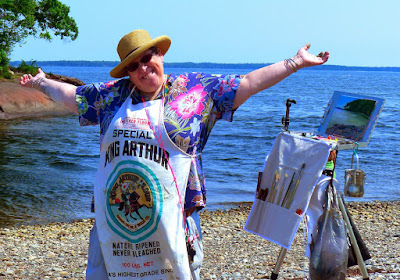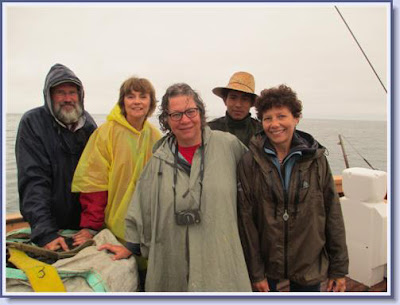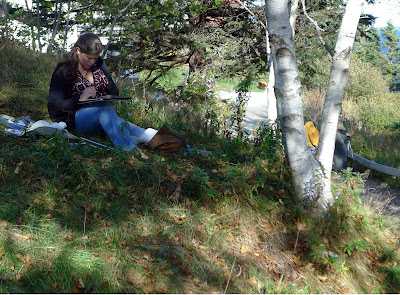A reader asks for advice teaching his first workshop.
 |
| Janith Mason at a Sea & Sky workshop. One of my all-time favorite photos of a student. |
It looks like the rain predicted for Monday has moved up to Sunday, but I’m prepared; I rented a shelter for this workshopmonths ago. It can be a fly tarp, a tent, a shelter, your studio, or a porch, but you must have a place for students to keep working when the weather goes bad. Rain is inevitable.
Your first and most important step, however, is to get consent from the places you’ll take your class. The rules change when you’re not alone. For example, if you bring a group to Acadia or another national park, you need a permit and proof that you’re carrying insurance (which you should have anyway). Many state and local parks have similar requirements. Historic sites often also charge a fee.
 |
| Rain is inevitable. Here we are getting soaked on the Monhegan ferry. |
If you’re painting a view along a street or road, remember to ask the property owner first. Stay on the sidewalks, the shoulder of the road, or in a pocket park if you’re in a public place.
You’re morally and legally responsible for the safety of your students. That’s why I don’t teach at Raven’s Nest in Schoodic, even though it’s a fantastic view. It’s not safe for big groups. Keep your people back from the road, and away from drop-offs and heavy equipment.
Know your own process and be able to break it down into discrete steps. Can you explain why you’re doing what you’re doing each step of the way? If not, go back and run through a painting in your studio and note each step. If you don’t have a consistent protocol, you’re probably not ready to teach.
 |
| You can’t demo convincingly unless you understand how and why you do each step in your process. |
In a similar vein, if you’re not a natural-born encourager and coach, teaching might not be the best option for you. Teaching painting is far more than just technical advice. Your own personality is the biggest indicator of your potential as a teacher.
Write supply lists and disseminate them freely. Mine are in this blog post. (No, I don’t mind if you use them as templates.)
Every workshop should have a focus. This weekend’s is the composition questions raised by the gently rolling landscape of the Genesee Valley. In The Age of Sail, it will be watercolor sketching on the fly. Sea & Sky at Schoodic is longer, so we work more intensively on essentials of painting rocks, water, trees and skies.
 |
| Students need time to work alone, but they also need your attention. |
Don’t take too many students. For me, twelve is about the maximum. Bigger classes end up with the teacher spending too much time demoing, and a video is cheaper and better for that. They’ve paid for your individual attention and problem-solving, and they should get them.
I do ask students to not spread out too far apart, or I spend all my time walking from person to person. When possible, I carry a bicycle with me to get from painter to painter faster.
 |
| The bottom line for a good workshop is one-on-one attention. Oh, and sunscreen. |
Any time I have more than six students, I engage a classroom monitor. This person is responsible for setting up my supplies, logistics and answering simple questions (but not for teaching).
Lastly, I carry a teaching bag containing extra boards, rain slickers, palette knife, and bug spray. People inevitably forget something, and we want them to have a good time.
Addendum: I forgot to mention restroom access here. In the deep wilds you can use a porta-potty or nature itself, but in more civilized place, find a site with public restrooms.
